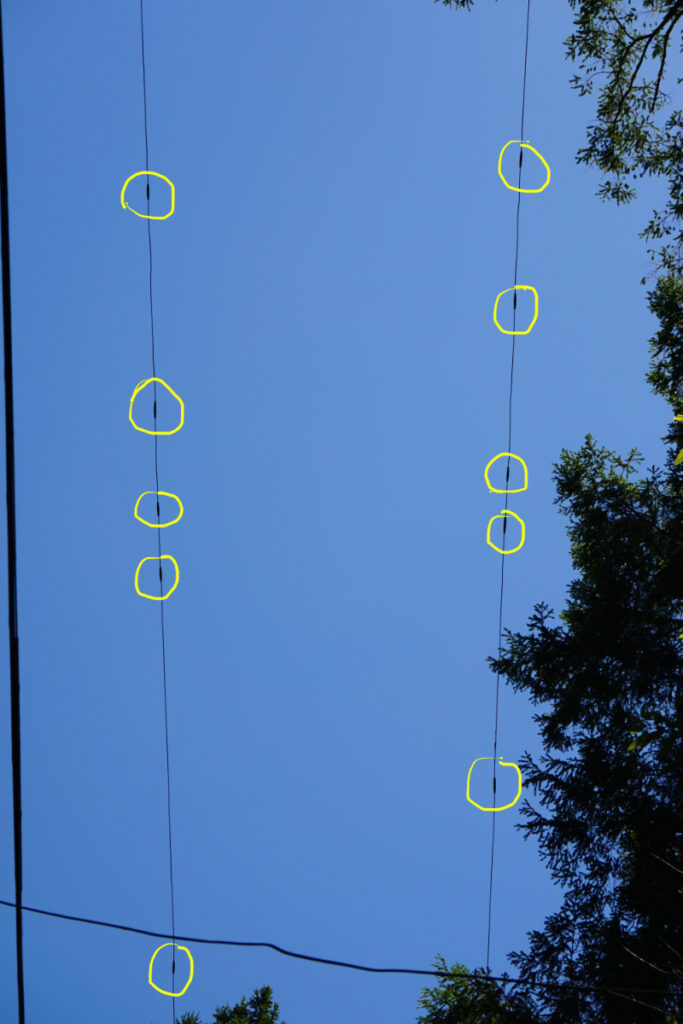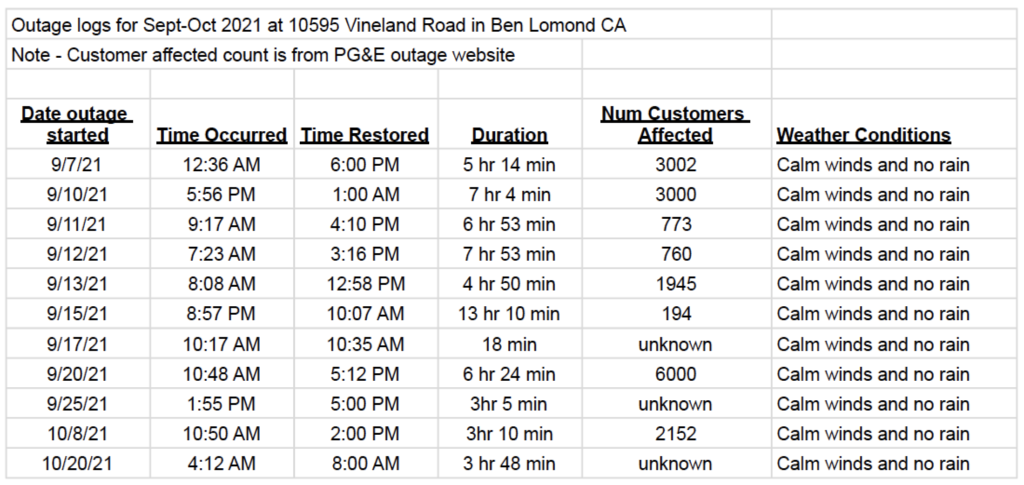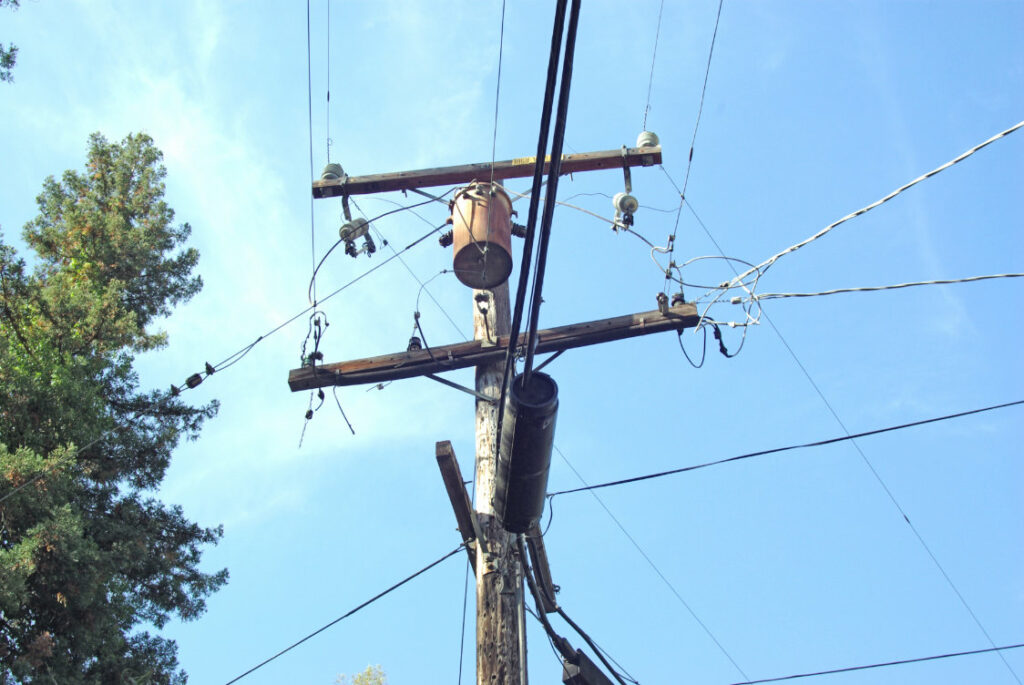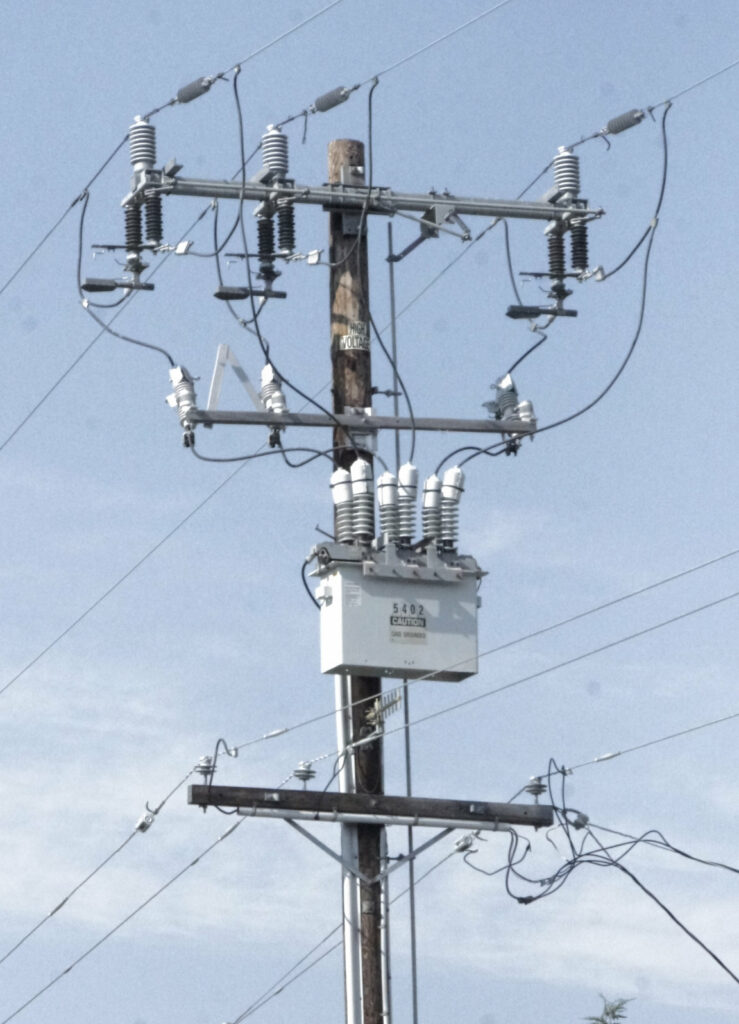Hey PG&E. What’s with all these Power Outages?
Public Safety Power Shutoffs (PSPS), Enhanced Powerline Safety Settings (EPSS) and Fast Trip
PG&E began to intentionally shut down their circuits during California’s fire seasons in 2019. This practice, called a Public Safety Power Shutoff, was first used by San Diego Gas and Electric in 2013. The idea is that when the wind and temperature come up with dry air and our dried out summer and autumn landscapes, a power company can turn off its distribution circuits to avoid starting wildfires. These events are announced in advance and associated with National Weather Service “Red Flag Warnings”. PG&E’S use of PSPS was particularly disruptive in 2019, when some areas in Northern California were without power for days.
Then in Summer 2021 PG&E began to recalibrate its reclosers (and perhaps other relays and circuit breakers) to shut down power faster at lower fault thresholds. PG&E calls this reset of its equipment “Enhanced Power Line Safety Settings” or “Fast Trip”. The curious irony is that reclosers were designed to keep the power on by reclosing (automatically switching power back on) because the majority of circuit faults are transitory. After three attempts, if the electrical fault is still present, the recloser locks open (power off).
PG&E started its practice of Fast Trip settings on 11,500 miles of lines in High Fire Threat Districts this July 2021. This practice has resulted in more than 500 unplanned power outages impacting more than half a million customers (source President of the CPUC). These Fast Trip power outages happen without notice and can last many hours.
To give you an example of the fragility of PG&E circuits, we have a report to the CA Public Utilities Commission (CPUC) from a consultant in 2013 stating that PG&E had in service about 22,000 circuit miles of small bare copper wire. It is very common to find multiple repair splices in a single span, as in this picture below. The yellow circles are wire repair splices.

To use this small fragile bare wire as a power conductor anywhere is asking for trouble.
To suspend it though tall forests is worse. But this wire is used all across Northern CA, both in forests and on city streets. This #6 wire is fully in compliance with CA Public Utilities Commission code. The Commission appears to have ignored both its own staff and outside consultant’s comments about this wire.
If you wonder why such defective regulations exist, you could ask our Governor. He appoints the five Commissioners who oversee the CPUC. General Order 95 allows the use of even smaller wire than this.
After a power outage PG&E must inspect every mile of power line for damage before it can safely turn the power back on again. Their linemen must locate and correct the problem that tripped off the power. Otherwise the company may start another wildfire or possibly electrocute someone. If PG&E had better situational awareness on its grid, then locating electrical fault problems might not take them so long. PG&E has limited SCADA (System Control and Data Acquisition). SCADA is an old technology.
Below is a Log Record of Recent Fast Trip Power Outages Recorded by a Person Living in Santa Cruz County

This is an amazing record of unplanned power outages – one that might be expected in a poor underdeveloped country. Ben Lomond is about 30 miles from Silicon Valley.
Reclosers


So you know what is tripping off your electricity, we include this photo (below) of a PG&E recloser. It’s the large grey box with ceramic insulators on top. PG&E uses at least three different types of reclosers. These may not be the only switch gear involved with Fast Trip power outages.

A recloser is a three phase circuit breaker. They were designed to reduce power outages by auto re-closing to test if an electrical fault had cleared. Many faults are transitory. This re-closing happens three to four times. Perhaps that fault was a squirrel that died and fell off the power pole, so the electrical problem was resolved?
But in 2017 it was found that reclosers were re-energizing downed power lines and starting fires.
Reclosers don’t distinguish what the fault is, and so reclosing or re-energizing without knowing why a circuit tripped off is too dangerous for wildfires during the dry season. Fast Trip does reduce fire ignitions. But there are better ways to accomplish this.
Reclosers are mounted on power poles and in sub-stations. In general principle, reclosers shut off power similarly to the circuit breakers in your house. Recloser devices are usually magnetic rather than thermal or heat operated. House circuit breakers are thermal. But both open a circuit during a power overload.
Sometimes bare powerlines swing in the wind and arc to each other, making flash sparking contact that showers pieces of molten metal. This is a powerful phase to phase arc fault. A line slap lasts only a moment. Reclosers were designed to turn the power on again after the power lines separated.
With Fast Trip, reclosers are being used for something they were not really intended for. That is: to open (or turn off) on low threshold overloads, and then not re-energize.
Newer Technology
In 2017 during the “Wine Country Fires”, it was determined that reclosers were starting fires by re-energizing downed powerlines. A downed powerline can arc to earth, start a fire, and not be shut off by any fuse or recloser on a standard setting. This older equipment just detects or fails to detect overloads. New computer equipment can distinguish between nearly every type of electrical fault. These devices can be mounted on power poles.
Power engineering companies have computer sensor and safety switch devices available today ready to install, on the shelf.
Two US companies that design and manufacture this equipment are:
General Electric
https://www.gegridsolutions.com/multilin/catalog/urfamily.htm
https://www.gegridsolutions.com/services/catalog/gridnode-highspeed-falling-conductor-protection.htm
Schweitzer Engineering
https://cdn.selinc.com/assets/Literature/Product Literature/Flyers/Arc-Sense_PF00160.pdf?v=20161031-143656
First developed at Texas A&M University, and other research facilities world-wide, this system includes “high impedance arc fault interruption.” With this system a small computer “watches” the waveform distortions in AC power. It can distinguish between different types of electrical faults, and the technology is not limited to high impedance faults alone. The computer tells a recloser, or other switch gear, to shut down, and then the computer can notify a utility operations center of the problem using a SCADA network.
With adequate equipment, this system locates the problem on the electrical grid.
New technology requires an investment of time and money. Without it, your inconvenience and personal risks become your problem. We’ve no idea what the management of PG&E think when it comes to these power outages. But in our opinion, there are better ways to prevent wildfires that do not involve repeated, hours long, power outages.
Overhead power circuits can be fire-safe. Southern California Edison is rebuilding circuits using hundreds of miles (soon to be thousands of miles) of new steel reinforced, triple insulated cable, as well as other new equipment. San Diego Gas and Electric has the majority of its distribution circuits undergrounded and has conducted circuit safety research and installations with engineering companies.
We don’t know if Enhanced Power Line Safety Settings (or Fast Trip) are going to be a long term strategy of PG&E to reduce its wildfire ignition liability.
We do know that the only way to have fire-safe overhead electrical circuits that are not subject to frequent power outages, is to update protection relays and install fully insulated cabling systems.
The only substitute for this is to put power circuits underground. Undergrounding also changes nearly ever building’s service connection. It will be very expensive to put the distribution circuits in all high utility fire threat districts underground. We have a CPUC staff report documenting unspent funding, in an agency process defined by CPUC “Rule 20A” for the years 2011 to 2015. Rule 20A was adopted when Ronald Regan was Governor of California. It was intended to promote undergrounding. Discussions about using Rule 20A for wildfire prevention have started.
